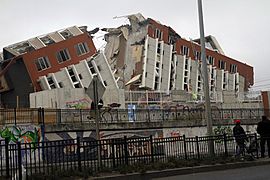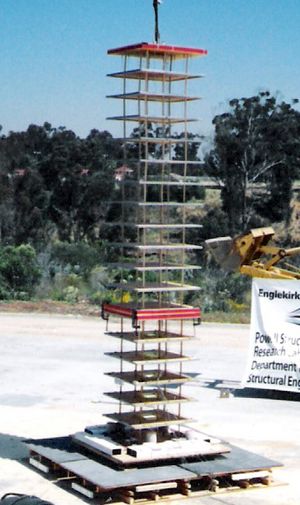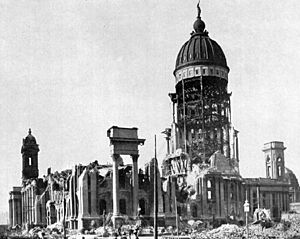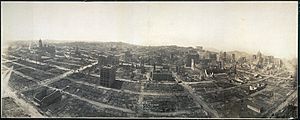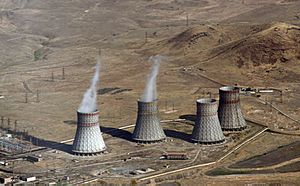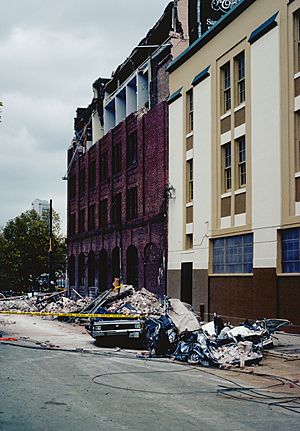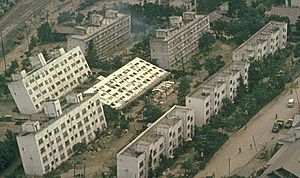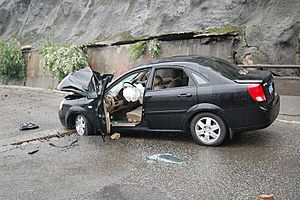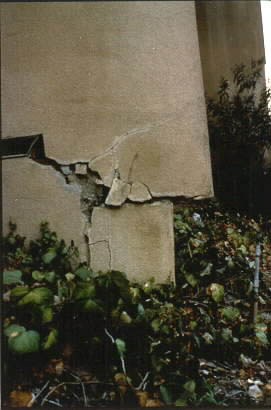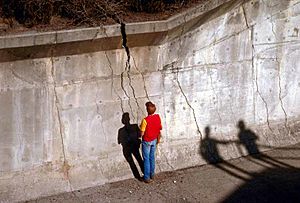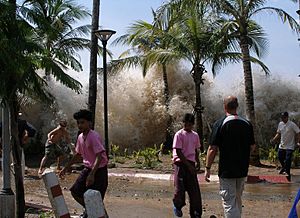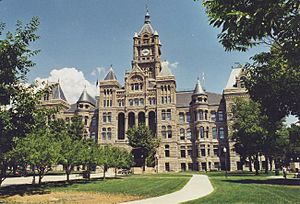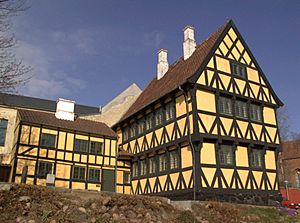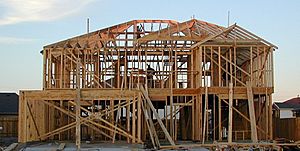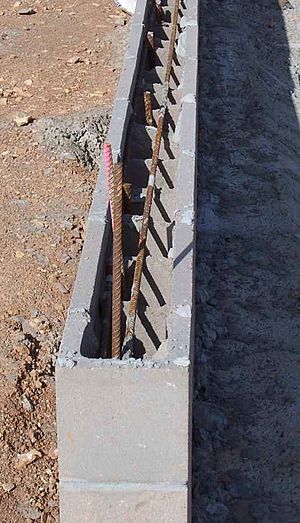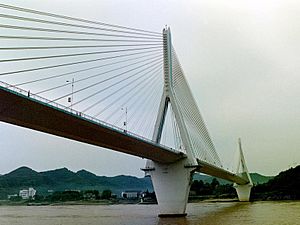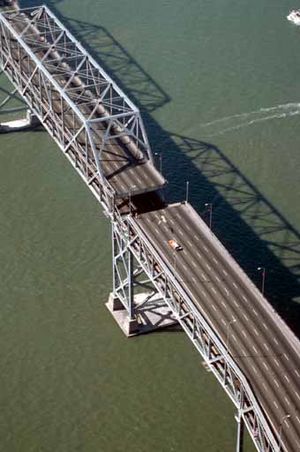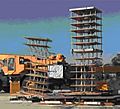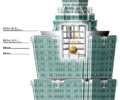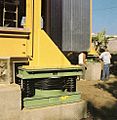Earthquake engineering facts for kids
Earthquake engineering is the study of the behavior of building structures subject to earthquake impacts. It is a subset of civil engineering.
Contents
Objectives of the earthquake engineering
The main goals of earthquake engineering are:
- Understand what happens between buildings and the ground.
- Understand what strong earthquakes or tsunamis might do to building structures.
- Design, build and maintain structures to last during an earthquake while following building codes.
Tools
A properly engineered structure does not necessarily have to be extremely strong or expensive.
The most powerful and affordable tools of earthquake engineering are vibration control technologies and, in particular, base isolation.
To test seismic performance of a building structure with experiments, it is may be put on a shake-table that behaves like the earth shaking. The earliest shake-table experiments were performed more than a century ago
Tsunami preparedness and protection
Tsunami or a chain of fast moving waves in the ocean caused, mostly, by powerful earthquakes is a very serious challenge for people's safety and for tsunami protection of buildings and civil infrastructure. Those waves can flood coastal areas, destroy houses and even swipe away whole towns.
Though tsunami can not be prevented, there are warning systems developed recently which warn the population before the big waves reach the land to let them enough time to rush to safety.
Seismic design
Seismic design is based on authorized engineering procedures, principles and criteria meant to design or retrofit structures subject to earthquake exposure. Those criteria are only consistent with the contemporary state of the knowledge about earthquake engineering structures. Therefore, a building design which exactly follows seismic code regulations does not guarantee safety against collapse or serious damage.
The price of poor seismic design may be enormous. Nevertheless, seismic design has always been a trial and error process whether it was based on physical laws or on empirical knowledge of the structural performance of different shapes and materials.
To practice seismic design, seismic analysis or seismic evaluation of new and existing civil engineering projects, an engineer should, normally, pass examination on Seismic Principles which, in the State of California, include:
- Seismic Data and Seismic Design Criteria
- Seismic Characteristics of Engineered Systems
- Seismic Forces
- Seismic Analysis Procedures
- Seismic Detailing and Construction Quality Control
To build up complex structural systems, seismic design largely uses the same relatively small number of basic structural elements (to say nothing of vibration control devices) as any non-seismic design project.
Normally, according to building codes, structures are designed to "withstand" the largest earthquake of a certain probability that is likely to occur at their location. This means the loss of life should be minimized by preventing collapse of the buildings.
Seismic design is carried out by understanding the possible failure modes of a structure and providing the structure with appropriate strength, stiffness, ductility, and configuration to ensure those modes cannot occur.
Seismic design requirements
Seismic design requirements depend on the type of the structure, locality of the project and its authorities which stipulate applicable seismic design codes and criteria. For instance, California Department of Transportation's requirements called The Seismic Design Criteria (SDC) and aimed at the design of new bridges in California incorporate an innovative seismic performance-based approach.
The most significant feature in the SDC design philosophy is a shift from a force-based assessment of seismic demand to a displacement-based assessment of demand and capacity. Thus, the newly adopted displacement approach is based on comparing the elastic displacement demand to the inelastic displacement capacity of the primary structural components while ensuring a minimum level of inelastic capacity at all potential plastic hinge locations.
In addition to the designed structure itself, seismic design requirements may include a ground stabilization underneath the structure: sometimes, heavily shaken ground breaks up which leads to collapse of the structure sitting upon it. The following topics should be of primary concerns: liquefaction; dynamic lateral earth pressures on retaining walls; seismic slope stability; earthquake-induced settlement.
Nuclear facilities should not jeopardise their safety in case of earthquakes or other hostile external events. Therefore, their seismic design is based on criteria far more stringent than those applying to non-nuclear facilities. The Fukushima I nuclear accidents and damage to other nuclear facilities that followed the 2011 Tōhoku earthquake and tsunami have, however, drawn attention to ongoing concerns over Japanese nuclear seismic design standards and caused other many governments to re-evaluate their nuclear programs. Doubt has also been expressed over the seismic evaluation and design of certain other plants, including the Fessenheim Nuclear Power Plant in France.
Failure modes
Failure mode is the manner by which an earthquake induced failure is observed. It, generally, describes the way the failure occurs. Though costly and time consuming, learning from each real earthquake failure remains a routine recipe for advancement in seismic design methods. Below, some typical modes of earthquake-generated failures are presented.
The lack of reinforcement coupled with poor mortar and inadequate roof-to-wall ties can result in substantial damage to an unreinforced masonry building. Severely cracked or leaning walls are some of the most common earthquake damage. Also hazardous is the damage that may occur between the walls and roof or floor diaphragms. Separation between the framing and the walls can jeopardize the vertical support of roof and floor systems.
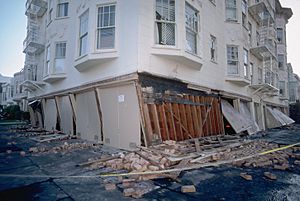
Soft story effect. Absence of adequate stiffness on the ground level caused damage to this structure. A close examination of the image reveals that the rough board siding, once covered by a brick veneer, has been completely dismantled from the studwall. Only the rigidity of the floor above combined with the support on the two hidden sides by continuous walls, not penetrated with large doors as on the street sides, is preventing full collapse of the structure.
Soil liquefaction. In the cases where the soil consists of loose granular deposited materials with the tendency to develop excessive hydrostatic pore water pressure of sufficient magnitude and compact, liquefaction of those loose saturated deposits may result in non-uniform settlements and tilting of structures. This caused major damage to thousands of buildings in Niigata, Japan during the 1964 earthquake.
Landslide rock fall. A landslide is a geological phenomenon which includes a wide range of ground movement, including rock falls. Typically, the action of gravity is the primary driving force for a landslide to occur though in this case there was another contributing factor which affected the original slope stability: the landslide required an earthquake trigger before being released.
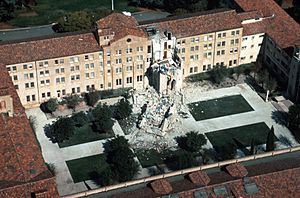
Pounding against adjacent building. This is a photograph of the collapsed five-story tower, St. Joseph's Seminary, Los Altos, California which resulted in one fatality. During Loma Prieta earthquake, the tower pounded against the independently vibrating adjacent building behind. A possibility of pounding depends on both buildings' lateral displacements which should be accurately estimated and accounted for.
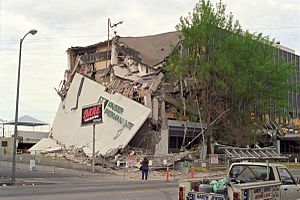
At Northridge earthquake, the Kaiser Permanente concrete frame office building had joints completely shattered, revealing inadequate confinement steel, which resulted in the second story collapse. In the transverse direction, composite end shear walls, consisting of two wythes of brick and a layer of shotcrete that carried the lateral load, peeled apart because of inadequate through-ties and failed.
- Improper construction site on a foothill.
- Poor detailing of the reinforcement (lack of concrete confinement in the columns and at the beam-column joints, inadequate splice length).
- Seismically weak soft story at the first floor.
- Long cantilevers with heavy dead load.
Sliding off foundations effect of a relatively rigid residential building structure during 1987 Whittier Narrows earthquake. The magnitude 5.9 earthquake pounded the Garvey West Apartment building in Monterey Park, California and shifted its superstructure about 10 inches to the east on its foundation.

If a superstructure is not mounted on a base isolation system, its shifting on the basement should be prevented.
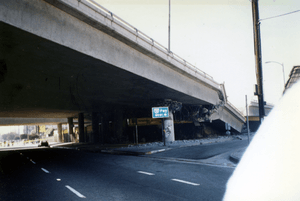
Reinforced concrete column burst at Northridge earthquake due to insufficient shear reinforcement mode which allows main reinforcement to buckle outwards. The deck unseated at the hinge and failed in shear. As a result, the La Cienega-Venice underpass section of the 10 Freeway collapsed.
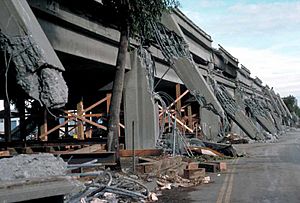
Loma Prieta earthquake: side view of reinforced concrete support-columns failure which triggered the upper deck collapse onto the lower deck of the two-level Cypress viaduct of Interstate Highway 880, Oakland, CA.
Retaining wall failure at Loma Prieta earthquake in Santa Cruz Mountains area: prominent northwest-trending extensional cracks up to 12 cm (4.7 in) wide in the concrete spillway to Austrian Dam, the north abutment.

Ground shaking triggered soil liquefaction in a subsurface layer of sand, producing differential lateral and vertical movement in an overlying carapace of unliquified sand and silt. This mode of ground failure, termed lateral spreading, is a principal cause of liquefaction-related earthquake damage.
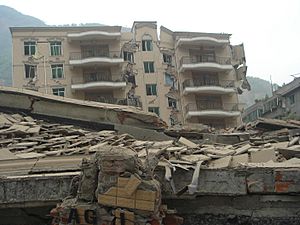
Severely damaged building of Agriculture Development Bank of China after 2008 Sichuan earthquake: most of the beams and pier columns are sheared. Large diagonal cracks in masonry and veneer are due to in-plane loads while abrupt settlement of the right end of the building should be attributed to a landfill which may be hazardous even without any earthquake.
Twofold tsunami impact: sea waves hydraulic pressure and inundation. Thus, the Indian Ocean earthquake of December 26, 2004, with the epicenter off the west coast of Sumatra, Indonesia, triggered a series of devastating tsunamis, killing more than 230,000 people in eleven countries by inundating surrounding coastal communities with huge waves up to 30 meters (100 feet) high.
Earthquake-resistant construction
Earthquake construction means implementation of seismic design to enable building and non-building structures to live through the anticipated earthquake exposure up to the expectations and in compliance with the applicable building codes.
Design and construction are intimately related. To achieve a good workmanship, detailing of the members and their connections should be as simple as possible. As any construction in general, earthquake construction is a process that consists of the building, retrofitting or assembling of infrastructure given the construction materials available.
The destabilizing action of an earthquake on constructions may be direct (seismic motion of the ground) or indirect (earthquake-induced landslides, soil liquefaction and waves of tsunami).
A structure might have all the appearances of stability, yet offer nothing but danger when an earthquake occurs. The crucial fact is that, for safety, earthquake-resistant construction techniques are as important as quality control and using correct materials. Earthquake contractor should be registered in the state/province/country of the project location (depending on local regulations), bonded and insured .
To minimize possible losses, construction process should be organized with keeping in mind that earthquake may strike any time prior to the end of construction.
Each construction project requires a qualified team of professionals who understand the basic features of seismic performance of different structures as well as construction management.
Adobe structures
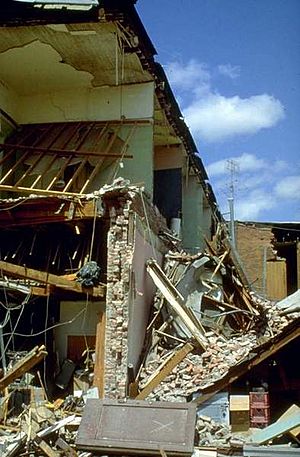
Around thirty percent of the world's population lives or works in earth-made construction. Adobe type of mud bricks is one of the oldest and most widely used building materials. The use of adobe is very common in some of the world's most hazard-prone regions, traditionally across Latin America, Africa, Indian subcontinent and other parts of Asia, Middle East and Southern Europe.
Adobe buildings are considered very vulnerable at strong quakes. However, multiple ways of seismic strengthening of new and existing adobe buildings are available.
Key factors for the improved seismic performance of adobe construction are:
- Quality of construction.
- Compact, box-type layout.
- Seismic reinforcement.
Limestone and sandstone structures
Limestone is very common in architecture, especially in North America and Europe. Many landmarks across the world are made of limestone. Many medieval churches and castles in Europe are made of limestone and sandstone masonry. They are the long-lasting materials but their rather heavy weight is not beneficial for adequate seismic performance.
Application of modern technology to seismic retrofitting can enhance the survivability of unreinforced masonry structures. As an example, from 1973 to 1989, the Salt Lake City and County Building in Utah was exhaustively renovated and repaired with an emphasis on preserving historical accuracy in appearance. This was done in concert with a seismic upgrade that placed the weak sandstone structure on base isolation foundation to better protect it from earthquake damage.
Timber frame structures
Timber framing dates back thousands of years, and has been used in many parts of the world during various periods such as ancient Japan, Europe and medieval England in localities where timber was in good supply and building stone and the skills to work it were not.
The use of timber framing in buildings provides their complete skeletal framing which offers some structural benefits as the timber frame, if properly engineered, lends itself to better seismic survivability.
Light-frame structures
Light-frame structures usually gain seismic resistance from rigid plywood shear walls and wood structural panel diaphragms. Special provisions for seismic load-resisting systems for all engineered wood structures requires consideration of diaphragm ratios, horizontal and vertical diaphragm shears, and connector/fastener values. In addition, collectors, or drag struts, to distribute shear along a diaphragm length are required.
Reinforced masonry structures
A construction system where steel reinforcement is embedded in the mortar joints of masonry or placed in holes and after filled with concrete or grout is called reinforced masonry.
The devastating 1933 Long Beach earthquake revealed that masonry construction should be improved immediately. Then, the California State Code made the reinforced masonry mandatory.
There are various practices and techniques to achieve reinforced masonry. The most common type is the reinforced hollow unit masonry. The effectiveness of both vertical and horizontal reinforcement strongly depends on the type and quality of the masonry, i.e. masonry units and mortar.
To achieve a ductile behavior of masonry, it is necessary that the shear strength of the wall is greater than the flexural strength.
Reinforced concrete structures
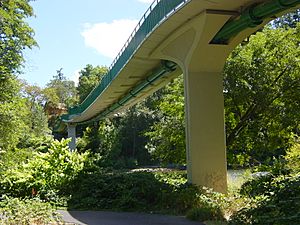
Reinforced concrete is concrete in which steel reinforcement bars (rebars) or fibers have been incorporated to strengthen a material that would otherwise be brittle. It can be used to produce beams, columns, floors or bridges.
Prestressed concrete is a kind of reinforced concrete used for overcoming concrete's natural weakness in tension. It can be applied to beams, floors or bridges with a longer span than is practical with ordinary reinforced concrete. Prestressing tendons (generally of high tensile steel cable or rods) are used to provide a clamping load which produces a compressive stress that offsets the tensile stress that the concrete compression member would, otherwise, experience due to a bending load.
To prevent catastrophic collapse in response earth shaking (in the interest of life safety), a traditional reinforced concrete frame should have ductile joints. Depending upon the methods used and the imposed seismic forces, such buildings may be immediately usable, require extensive repair, or may have to be demolished.
Prestressed structures
Prestressed structure is the one whose overall integrity, stability and security depend, primarily, on a prestressing. Prestressing means the intentional creation of permanent stresses in a structure for the purpose of improving its performance under various service conditions.
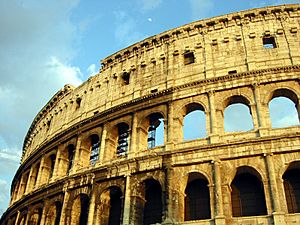
There are the following basic types of prestressing:
- Pre-compression (mostly, with the own weight of a structure)
- Pretensioning with high-strength embedded tendons
- Post-tensioning with high-strength bonded or unbonded tendons
Today, the concept of prestressed structure is widely engaged in design of buildings, underground structures, TV towers, power stations, floating storage and offshore facilities, nuclear reactor vessels, and numerous kinds of bridge systems.
A beneficial idea of prestressing was, apparently, familiar to the ancient Rome architects; look, e.g., at the tall attic wall of Colosseum working as a stabilizing device for the wall piers beneath.
Steel structures
Steel structures are considered mostly earthquake resistant but some failures have occurred. A great number of welded steel moment-resisting frame buildings, which looked earthquake-proof, surprisingly experienced brittle behavior and were hazardously damaged in the 1994 Northridge earthquake. After that, the Federal Emergency Management Agency (FEMA) initiated development of repair techniques and new design approaches to minimize damage to steel moment frame buildings in future earthquakes.
For structural steel seismic design based on Load and Resistance Factor Design (LRFD) approach, it is very important to assess ability of a structure to develop and maintain its bearing resistance in the inelastic range. A measure of this ability is ductility, which may be observed in a material itself, in a structural element, or to a whole structure.
As a consequence of Northridge earthquake experience, the American Institute of Steel Construction has introduced AISC 358 "Pre-Qualified Connections for Special and intermediate Steel Moment Frames." The AISC Seismic Design Provisions require that all Steel Moment Resisting Frames employ either connections contained in AISC 358, or the use of connections that have been subjected to pre-qualifying cyclic testing.
Prediction of earthquake losses
Earthquake loss estimation is usually defined as a Damage Ratio (DR) which is a ratio of the earthquake damage repair cost to the total value of a building. Probable Maximum Loss (PML) is a common term used for earthquake loss estimation, but it lacks a precise definition. In 1999, ASTM E2026 'Standard Guide for the Estimation of Building Damageability in Earthquakes' was produced in order to standardize the nomenclature for seismic loss estimation, as well as establish guidelines as to the review process and qualifications of the reviewer.
Earthquake loss estimations are also referred to as Seismic Risk Assessments. The risk assessment process generally involves determining the probability of various ground motions coupled with the vulnerability or damage of the building under those ground motions. The results are defined as a percent of building replacement value.
Images for kids
-
Shake-table crash testing of a regular building model (left) and a base-isolated building model (right) at UCSD
-
Tokyo Skytree, equipped with a tuned mass damper, is the world's tallest tower and is the world's second tallest structure.
-
Shake-table testing of Friction Pendulum Bearings at EERC
-
NEES at Buffalo testing facility
-
Mausoleum of Cyrus, the oldest base-isolated structure in the world
-
Dry-stone walls of Machu Picchu Temple of the Sun, Peru
-
Tuned mass damper in Taipei 101, the world's third tallest skyscraper
-
LRB being tested at the UCSD Caltrans-SRMD facility
See also
 In Spanish: Ingeniería sísmica para niños
In Spanish: Ingeniería sísmica para niños


